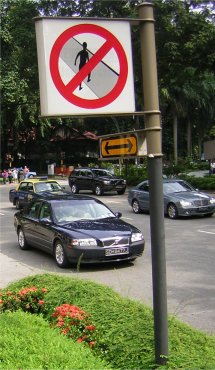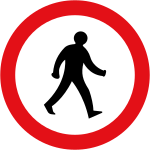Jaywalking
In many countries, the word is not generally used and, with the exception of certain high-speed roads such as motorways, there are no laws limiting how pedestrians are allowed to cross public highways.
Thus, globally speaking, legal texts use different concepts, one of which is Rules applicable to pedestrians, put forward by the Vienna Convention on Road Traffic.
[4] As an example of the subtleties and discrepancies of the laws governing pedestrian road traffic, even as a signing member of the Vienna convention, the United Kingdom does not have jaywalking laws: its Highway Code relies on the pedestrians making their own judgment on whether it is safe to cross based on the Green Cross Code.
[8] Originally in the US, the legal rule was that "all persons have an equal right in the highway, and that in exercising the right each shall take due care not to injure other users of the way".
People jaywalk for various reasons, including convenience, the expectation of the right to free movement of individuals, and sometimes even personal safety, generally to cross the street.
[11][12] Pedestrians are often forced to walk outside crosswalks, when they are blocked by cars due to traffic congestion or drivers stopping too far forward.
The common practice of car-centric traffic-signal synchronisation produces green waves for motorists but not necessarily for pedestrians, who may encounter little or no conflicting traffic at cross streets where signals instruct them to wait.
Pedestrians may dislike crossing at intersections for other reasons, such as discomfort dealing with traffic from several directions (whereas a jaywalker at a location distant from an intersection only needs to observe at most two directions of traffic), or wanting to avoid the extra air emissions generated by vehicles stopping and starting (given that vehicular emissions are significantly less when vehicles are moving at steady speeds).
[13]: 198 Many American newspapers publish stories that are critical of pedestrian road users' safety practices, while police departments often instigate education and enforcement campaigns to curb jaywalking.
Disregarding designated crossing points or passing through red traffic lights carries a punishment of up to six months in jail or a US$20 fine, as part of the new Highway Code.
[14] In many Asian countries, the low level of traffic control means that jaywalking is often more of a necessity to a pedestrian and is rarely punished except in major commercial hubs such as Singapore.
[citation needed] In recent years, jaywalking has become more strictly controlled in China as car traffic increased.
[19] Israeli transit regulations section 110[20] states a person shall not cross a road unless they have checked to make sure it is safe to do so.
Israeli courts have ruled that the legislature left the term "nearby" deliberately vague and it must be evaluated on a case-by-case basis.
[31] It is however, illegal to cross or traverse an expressway on foot based on the Revised Rules and Regulations Governing Limited Access Highways.
3, StVO (VwV), must watch the vehicular traffic carefully and cross a street quickly and using the shortest way across the driving lanes.
Cars and bikes are required by law to give way to pedestrians (but not bicycle riders) at zebra crossings unless there is a traffic light.
[47] Whilst jaywalking is not specifically defined by the Hungarian Highway Code (KRESZ) as an offence, various restrictions and prohibitions apply for pedestrians crossing or walking along roads.
[72] A 2014 Yougov poll found 77% of Britons believed walking on roads when it is safe to do so should remain legal; 14% favored making it illegal.
[73] A similar US Yougov poll found 30% believed "jaywalking" should be legal—in most settlements, there is next to no centuries-old societal norm of specific roads on which it may in daytime be safe to walk, such as horse-frequented, cobbled or hump-calmed rural village.
No law on jaywalking exists at the federal level, although several provinces, territories, and municipalities have enacted regulations or by-laws that restrict when a pedestrian may cross a roadway.
[86][87] Most of these provincial regulations, in addition to municipal by-laws, do not use the term jaywalking to describe when a pedestrian unlawfully crosses a roadway.
[83] As a result of differing provincial/territorial regulations and/or municipal by-laws, the fine that is charged for crossing a motorway varies across the country, from C$30 in Quebec, to C$697.50 in Nova Scotia.
Signs, fences, and barriers of various types (including planted hedges) have been used to prohibit and prevent pedestrian crossing at some locations.
The meanings of pedestrian signal indications are summarised in Section 4E.02 of the national Manual on Uniform Traffic Control Devices.
In some cities, such as New York City, Chicago, Los Angeles, and Boston, although prohibited, "jaywalking" has been so common that police generally cite or detain jaywalkers only if their behavior is considered excessively dangerous or disruptive, such as running out in front of a moving vehicle or crossing after the light is about to change to allow cross traffic to proceed.
It bars law enforcement from stopping and citing a pedestrian for "safe mid-block crossings" except in the circumstances where "a reasonably careful person would realize there is an immediate danger of a collision".
Some known environmental factors include absence of midblock crosswalks, width of roads, poor timing of crossing signals, poor conditions of sidewalks, absence of sidewalks in certain areas, capacity of sidewalks, weather, people with limited mobility, people with occupational risks, children and teens, parking areas near shopping centers, street repair and construction sites, major highways, one-way streets, location of attractions, and unlawful street-vending.
[97][98] The bill, AB 2147, The Freedom To Walk Act, passed by the legislature and signed by Governor Gavin Newsom, took effect on January 1, 2023.
According to CONTRAN resolution 706/17 from April 25, 2018, violators could pay a fine up to 44.19 Brazilian reals; however, the measure is rarely enforced.













